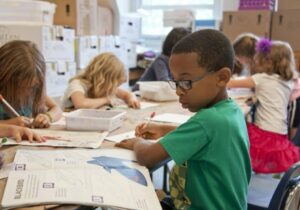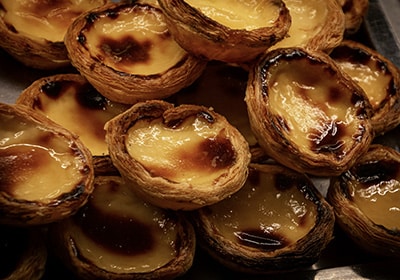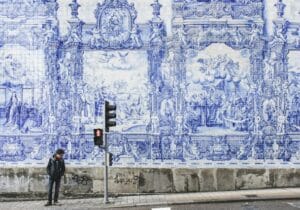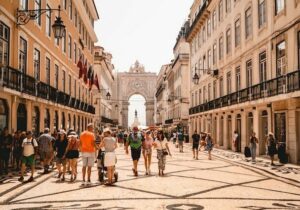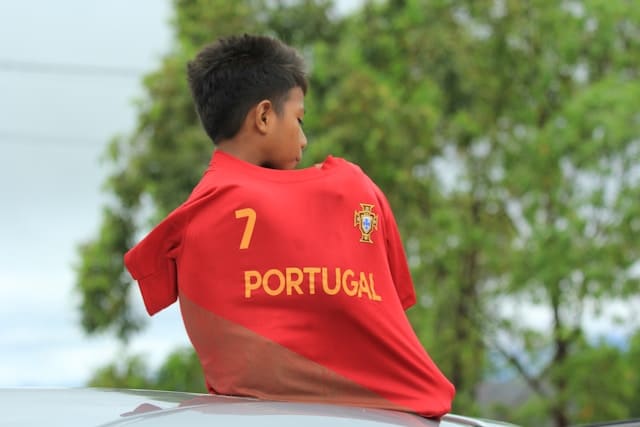Moving to a new country is never easy, but life improves every day if you integrate with the local population. This means getting to know your neighbors, finding the best spots to grab lunch, and, of course, engrossing yourself in Portuguese culture.
Portuguese culture is a vibrant fusion of historical influences, traditional values, and regional diversity. It is marked by a strong sense of family, a respect for tradition, and a warm, hospitable nature. Key elements of this culture include a profound appreciation for art, music, and folklore, as well as a distinctive architectural style that prominently features decorative tiles. However, not all aspects of Portuguese traditions are the same, depending on where you live. The Algarve is as distinct in beliefs and values as Porto is in local delicacies such as francesinha and Port wine.
In this article, we’ll take a closer look at Portuguese traditions and celebrations, explore some regional foods and drinks, and how Portuguese family traditions have shaped the histories of other countries.
You’ll also find out more about:
- Portuguese language and identity
- Music, art, and architecture
- Portuguese cuisine
- Family and daily life
- Portugal’s football culture
- Religious festivals
While Roman and Visigothic architecture can still be found throughout Portugal, pinpointing the exact time when the “modern” Portuguese culture emerged is challenging. However, most historians point to a date that most of today’s Portuguese will be familiar with.
It all started coming together in 1139, when Afonso Henriques declared himself King of Portugal and broke away from the Kingdom of León.
Four years later, in 1143, the Treaty of Zamorra formally recognized Portugal as an independent kingdom, marking Portugal’s political and cultural birth, with its own monarchy, legal systems, and emerging identity.
This continued to evolve into its recognizable modern form during the Middle Ages and the Age of Discovery, influencing other countries such as Brazil, Mozambique, Angola, Goa in India, and, surprisingly, Japan.
While the standardized European Portuguese you learn in classrooms is centered on Lisbon norms, locals immediately recognize one another’s origins through subtle, and sometimes not-so-subtle, phonetic and lexical markers.
Centuries of regional history and cultural exchange created pockets in the country with distinct accents, vocabulary, and speech rhythms. Here are a few interesting examples:
Northern cadence (Minho, Trás-os-Montes, Douro): Up in the north, speakers tend to pronounce final vowels more fully—so that “porta” (door) sounds almost like “portah”—and they slide consonant clusters with a slight musicality. You’ll also hear the “s” at the ends of words pronounced as a soft “sh,” giving words like “mais” (more) a whispering finish.
Central plain (Lisbon, Santarém): Lisbon’s accent is often considered the “standard,” but even here, you’ll notice the characteristic “retracted” guttural, back-of-the-throat “r” and a tendency to swallow unstressed vowels. Casual Lisbon speech turns “amada” (beloved) into something like “âmda.”
Alentejo drawl: In the Alentejo, speech slows down to match the region’s wide plains, with elongated vowels and a softening of sibilants. Words stretch out: “amigo” becomes “aa-mi-goo”, and the overall effect is one of relaxed warmth.
Algarve lilt: Along the southern coast, Algarvians blend Portuguese with lingering Moorish influences: the “ch” may soften to more of an “sh” sound, and everyday speech is peppered with Arabic-derived words—“xara” (jarra, jug) and “algarvio” (local).
Speaking Portuguese is challenging for some foreigners, and with all the regional dialects, you have to ensure that you get the right tutor before taking your Portuguese language test. Proving you have the chops to converse, read, and write is a requirement for citizenship, especially for Portugal Golden Visa and Portugal D7 Visa holders.
Portuguese culture is a blend of deep-rooted traditions, historical resilience, and openness to global influences. At its core, Portugal and its people are shaped by their maritime past, which is evident in their national character, which is defined by exploration, adaptability, and hospitality.
Its heritage combines Mediterranean warmth with Atlantic resilience, creating a society comfortable with both tradition and change. Portuguese identity is closely tied to its language, reinforcing connections from Brazil to Angola. This legacy has fostered a deep sense of hospitality, tolerance, and curiosity toward other cultures.
Family and community also hold a significant place in Portuguese identity, with traditions preserved through festivals and music.
Portugal’s culture is best described as gracefully traditional yet open-minded, deeply emotional yet quietly resilient, creating a distinctive and inviting identity that warmly welcomes visitors and new residents alike.
Often referred to as “The Soul of Portugal,” the musical style is recognized by UNESCO as an Intangible Cultural Heritage of Humanity.
Generally, there are two variations of fado: Lisbon fado is more theatrical and widely known, while Coimbra fado is performed by male university students and is more classical and poetic.
Another culturally important musical style recognized by UNESCO is Cante Alentejano, which means “singing from the Alentejo region.” Covering themes of rural life, nature, love, and social issues, polyphonic choral singing is usually performed by male groups, often without instruments.
- Cozido à Portuguesa: Slow-simmered stew of meats and vegetables.
- Caldo verde: Green soup made with kale and chouriço.
- Pastel de nata: Creamy custard tart with a caramelized top.
- Bacalhau à Brás: Salt cod dish made with shredded cod, scrambled eggs, and crispy matchstick potatoes.
- Sardinhas Assadas: Grilled sardines served whole, especially popular during summer.
- Arroz de Marisco: Flavorful seafood rice stew, often compared to paella but with a distinctly Portuguese taste.
- Carne de Porco à Alentejana: A regional favorite combining marinated pork, clams, garlic, and paprika.
No Portuguese meal should ever be served without something to drink, and there are lots to choose from. Authentic Portuguese wines are defined by their use of native grape varieties, traditional production methods, and strong ties to specific regions.
Port wine is one of the most internationally recognized wines from Portugal. It is a fortified wine and has been produced for centuries in the terraced vineyards of the Douro Valley, a UNESCO World Heritage site. Port wine plays an important role in Portuguese celebrations and is often enjoyed as a dessert wine.
Vinho Verde, meaning “green wine” or “young wine,” is light, fresh, and often slightly effervescent. It is a staple in northern Portugal, especially during the summer, and pairs perfectly with local fish and seafood.
Beyond tiles, regions like Barcelos and Coimbra are known for their colorful earthenware, including hand-painted plates, jugs, and figurines adorned with floral and rooster motifs. Each piece carries local symbolism, such as the Barcelos Rooster, which represents luck and justice in Portuguese folklore.
Portugal is also the world’s leading producer of cork. Artisans have transformed this humble material into both functional and decorative items.
From fashion accessories like cork handbags to wall coverings and acoustic panels, cork’s versatility and sustainability provide a modern twist on traditional craftsmanship.
Portuguese architecture typically showcases a blend of styles that reflect the country’s rich history, regional diversity, and strong connection to light, color, and craftsmanship.
Manueline style
The Manueline style emerged during Portugal’s Age of Discoveries in the early 1500s, blending late Gothic architecture with maritime motifs. This style features intricate designs such as twisted ropes, armillary spheres, sea flora, and heraldic symbols carved in limestone.
Notable examples include the elaborate façades and cloisters of the Jerónimos Monastery in Belém and the richly sculpted portal of the Convent of Christ in Tomar, where every column and cornice celebrates Portugal’s global influence.
Pombaline style
Whitewashed houses
In towns and villages, from the beaches in the Algarve to the streets of Évora, simple, whitewashed houses with gently sloping red-tile roofs are common. Their bright walls provide relief from the summer heat and serve as canvases for the painted ceramic tiles.
Traditions within Portuguese families are preserved through regular Sunday lunches and annual celebrations like Christmas and Easter, where sharing traditional meals becomes a cherished ritual.
Family cohesion is strengthened by collective experiences around the table, where dishes like cozido à portuguesa and homemade desserts reinforce a sense of unity and belonging.
Portuguese daily life strikes a balance between industriousness and leisure. Although Portugal has increasingly urbanized, particularly in Lisbon and Porto, the rhythm of daily life remains relaxed, prioritizing relationships and human interactions over rigid schedules.
A strong café culture characterizes the Portuguese daily routine, where short coffee breaks, known as bicas (espresso shots), punctuate the day, allowing moments for socializing, reflection, and respite.
Work-life balance is respected, with evenings typically dedicated to family or social gatherings, often accompanied by leisurely dinners, relaxation, or walks by the coast or through historic city centers.
Here are a few significant cultural festivals in Portugal:
Festa de Santo António / Saint Anthony (Lisbon): Celebrated annually in June, Lisbon’s patron saint Anthony festival transforms neighborhoods into vibrant street parties with grilled sardines, traditional music, and dancing throughout the night.
Festa de São João (Porto): Held on June 23rd and 24th, this popular festival involves lively street festivities, bonfires, fireworks, playful traditions like hitting friends lightly with plastic hammers, and the launching of illuminated sky lanterns.
Semana Santa (Holy Week): Especially significant in Braga, Holy Week involves solemn religious processions, rituals, and ceremonies commemorating the passion and resurrection of Jesus Christ, attracting thousands of pilgrims and visitors.
Fátima Pilgrimage (May 13 & October 13): Marking apparitions of the Virgin Mary in Fátima in 1917, pilgrims from around the world gather annually for candlelit processions, prayer, and devotion, making it a globally significant spiritual event.
Festa dos Tabuleiros (Tomar): The Festival of Trays is celebrated every four years. It features an impressive procession of hundreds of women dressed in white, each carefully balancing a towering tray, or tabuleiro, on their heads, adorned with loaves of bread and colorful paper flowers.
From its long history of club rivalries to the international recognition of the national team, football has become one of the country’s fundamental forms of identity expression.
This is especially true in Lisbon and Porto, where clubs like Benfica, Sporting, and FC Porto boast some of the oldest and most successful teams, which rival each other in epic matches that spark citywide anticipation. FC Porto’s uniforms mirror the blue and white tiles found across Portuguese architecture, making them iconic symbols in both sport and design.
The country has produced legends like Eusébio and Cristiano Ronaldo, both of whom have won worldwide acclaim, while local coaches and composers, from Luís de Freitas Branco to Pedro Amaral, have noted the game’s influence on art form, rhythm, and performance.
Football unites generations and classes—from aristocrats to the middle class—making it one of Portugal’s few truly universal pastimes. This widespread reverence has inspired everything from fado performance tributes to scholarly work from institutions like the Gulbenkian Foundation, reinforcing its place within Portugal’s rich heritage.
In Portugal, football isn’t a distraction—it’s part of the architecture of life, a form of dramatic theatre tradition, and one of the most widely celebrated dimensions of Portugal’s history.
Portugal might be a small country compared to most others in Europe, but several regions have distinct local and regional customs. These traditions, ranging from culinary customs to folk music and crafts, have been passed down for generations, and often times, can be found nowhere else in Iberia.
Caretos de Podence (Trás-os-Montes)

In northern Portugal, particularly in Podence, the Caretos tradition marks the end of winter and welcomes spring. Young men dressed in brightly colored costumes, adorned with bells and masks, energetically chase villagers in playful rituals symbolizing renewal, fertility, and the rebirth of nature.
Pauliteiros de Miranda (Miranda do Douro)
From Miranda do Douro in northeastern Portugal, this traditional dance involves men dressed in regional costumes who skillfully strike wooden sticks to rhythmic melodies. It’s an ancient warrior dance reflecting local history and communal pride.
Vinho da Talha (Alentejo)
A traditional method of winemaking unique to the Alentejo region, involving fermentation in large clay amphorae known as talhas. Every November, communities gather to taste and celebrate the year’s wine in festive, communal settings.
Romaria de Nossa Senhora d’Agonia (Viana do Castelo)
In Viana do Castelo, this lively pilgrimage held in August showcases vibrant costumes, folklore dances, and decorated fishing boats. It’s a celebration deeply rooted in maritime traditions, blending religion and local heritage.
If you’re considering making the move to Portugal, it’s essential to be informed about the various visa and residency options available. The Golden Visa Portugal program is an attractive option for many, offering residency to investors and their families. For those eyeing retirement in this beautiful country, the Portugal D7 Visa is tailored for you. Digital nomads can take advantage of both short and long-stay options with the Digital Nomad Visa (D8).
For the entrepreneurial spirit, Portugal offers the Entrepreneurship/startup Visa (D2) – Start-up Visa (open company) tailored for those looking to establish their businesses in the country. Those with specialized skills can explore the Work visa for highly qualified employees (D3). Additionally, if you have Portuguese ancestry, you might be eligible for Citizenship by descent.
However, moving to a new country isn’t just about visas. If you’re thinking of buying property, our guide on Buying Property in Portugal can offer invaluable insights. Dive deeper into the immigration process with our comprehensive Portugal immigration guide. For Americans specifically looking to relocate, we have curated information on Americans moving to Portugal. Lastly, one can’t forget the importance of the NIF (Tax Identification Number), a crucial step in any relocation process.

